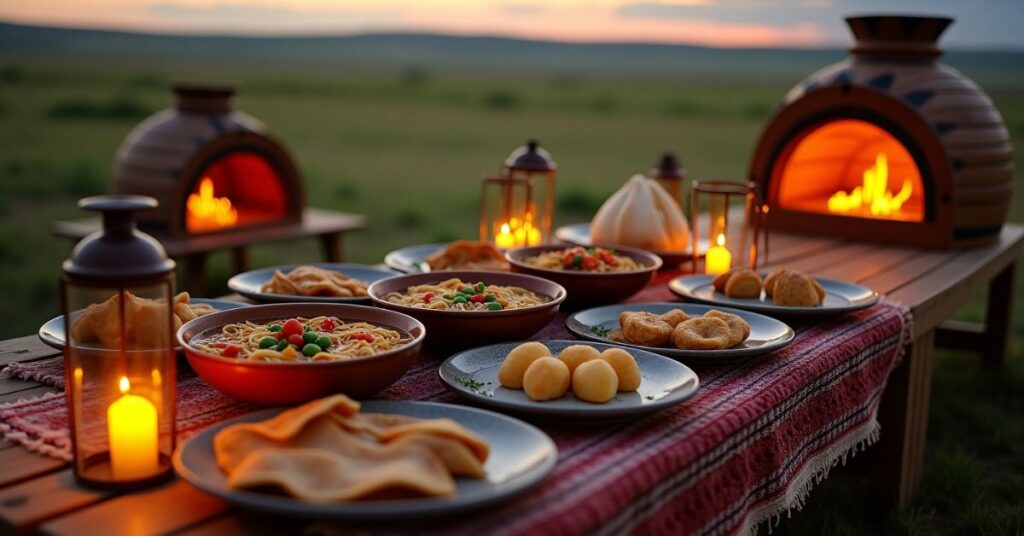Kazakhstan, a vast and diverse country, is home to stunning landscapes like the Altai Mountains, Charyn Canyon, and the Caspian Sea coastline. Its cities, including Almaty and Nur-Sultan, blend modern architecture with rich history, making them must-visit destinations. Beyond the sights, Kazakhstan’s culinary heritage is an essential part of its culture.
Known for its hearty and flavorful dishes, Kazakhstan’s cuisine reflects its nomadic roots. The use of horse and camel meat, dairy, and aromatic spices creates a unique taste experience. Visitors often find themselves captivated by the blend of traditional flavors that tell stories of hospitality and heritage.
From the savory Beshbarmak and fried Baursak to the rich Kazy sausage, every dish offers a glimpse into Kazakh traditions. Kumis and Shubat provide a taste of nomadic life, while Plov, Kuyrdak, and breads like Tandyr Nan and Shelpek showcase diverse flavors. Enjoying a cup of Kazakh tea completes the experience, making these dishes a must-try for any traveler.
Kazakhstan food

Beshbarmak
Known as Kazakhstan’s national dish, Beshbarmak is a hearty and comforting meal made with boiled meat, often horse or lamb, served over flat noodles with a savory broth and caramelized onions. Its name means “five fingers,” highlighting the traditional way of eating it by hand. This dish reflects the nomadic lifestyle, offering a nourishing and satisfying experience. The combination of tender meat, aromatic broth, and soft noodles makes Beshbarmak a must-try for anyone looking to experience authentic Kazakh flavors.
Baursak
Baursak is a popular deep-fried dough delicacy, often served during festive gatherings. Made from a simple dough of flour, yeast, salt, and sugar, these golden, crisp, and fluffy pieces are both irresistible and symbolic of hospitality. Whether square-shaped, circular, or triangular, Baursak’s slightly sweet taste and airy texture make it a delightful snack or side dish, perfect with a warm cup of tea. This traditional treat embodies the warmth and generosity of Kazakh culture.
Kazy
Kazy is a unique and flavorful sausage made from horsemeat, seasoned with garlic and black pepper, then air-dried and cured. Its robust and tangy flavor is a result of the careful preparation and traditional methods of fermenting and drying. Served thinly sliced, Kazy is a staple at celebrations and special occasions, offering a taste of the rich nomadic heritage. Its savory and slightly smoky notes pair perfectly with fresh bread and pickles.
Kumis – mare’s milk
Kumis, a fermented mare’s milk, holds a special place in Kazakh culture for its medicinal and revitalizing properties. Tangy and slightly effervescent, this drink is known to boost energy and strengthen the immune system. Often enjoyed during the warmer months, Kumis reflects the nomadic traditions of preserving dairy for long journeys across the steppes. Its unique flavor is an acquired taste but worth trying for an authentic Kazakh experience.
Shubat – camel’s milk
Shubat, made from fermented camel’s milk, is another traditional drink prized for its nutritional benefits. Rich in protein and probiotics, this sour and creamy beverage is a staple in the southern regions of Kazakhstan. Its thick texture and distinctive taste make it a unique offering that reflects the resourcefulness of nomadic life in arid deserts. Shubat is often served to guests as a sign of hospitality and respect.
Tea
Tea holds a significant place in Kazakh culture, often served in a traditional samovar. Black tea, infused with herbs like saffron or mint, is brewed strong and enjoyed with sugar or milk. Sharing tea is a symbol of warmth and hospitality, often accompanied by snacks like kurt, a salty dried yogurt. The act of pouring tea is also ceremonial, with smaller cups indicating a desire for guests to stay longer.
Plov – rice pilaf
Plov is a beloved rice pilaf dish made with basmati rice, lamb or chicken, carrots, onions, and spices like paprika and cumin. Slow-cooked to perfection, it absorbs the flavors of the meat and spices, resulting in a golden hue and rich aroma. This hearty and satisfying dish is often served at large gatherings, reflecting the communal spirit of Kazakh cuisine. Its layers of textures and flavors make Plov a filling and flavorful main course.
Kuyrdak
Kuyrdak is a traditional dish made from sautéed meat, usually lamb or beef, with onions and potatoes, seasoned with herbs and spices. Its earthy and satisfying flavors are enhanced by slow cooking, which tenderizes the meat and infuses the broth with rich aromas. Often enjoyed in the countryside, Kuyrdak showcases the rustic and hearty aspects of Kazakh cuisine, providing a nourishing meal that reflects the simplicity and resourcefulness of nomadic life.
Tandyr Nan
Tandyr Nan is a type of bread baked in a clay oven, resulting in a golden brown crust and a soft, fluffy interior. Its slightly smoky flavor and chewy texture make it the perfect accompaniment to hearty stews and soups. This circular bread is often decorated with patterns and served warm, symbolizing hospitality and community. Tandyr Nan’s preparation is a skill passed down through generations, making it a cherished staple of Kazakh meals.
Shelpek – Central Asian flatbread
Shelpek is a thin, circular flatbread made from basic dough with baking powder, fried until crispy and flaky. Often enjoyed with tea, this bread’s delicate texture and mild flavor make it a versatile side dish. Its preparation is straightforward yet requires skill to achieve the perfect balance of crispness and softness. Shelpek’s presence at both casual meals and festive occasions highlights its role as a beloved part of Kazakhstan’s culinary traditions.
Kazakhstan’s traditional food offers a journey through its history and culture, where each dish tells a story of nomadic life, hospitality, and the art of preserving flavors. From the hearty meats and fragrant spices to the rich dairy and freshly baked breads, the cuisine is a celebration of the nation’s vibrant heritage. Exploring these dishes is more than just tasting food—it’s an invitation to understand and appreciate the warmth and resilience of Kazakh culture.
FAQ’s
What is Kazakhstan’s national dish?
Beshbarmak, a hearty meal of boiled meat and noodles served with broth and onions.
What are Kumis and Shubat made from?
Kumis is made from fermented mare’s milk, while Shubat is made from fermented camel’s milk.
What is Baursak in Kazakh cuisine?
Baursak is a deep-fried dough snack that is crisp, fluffy, and slightly sweet.

